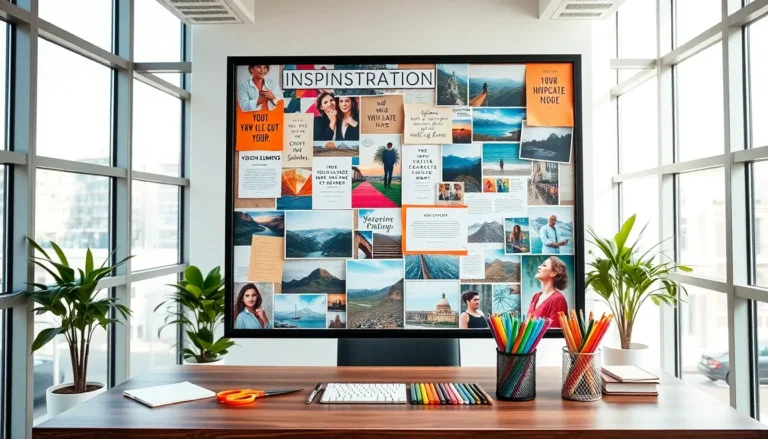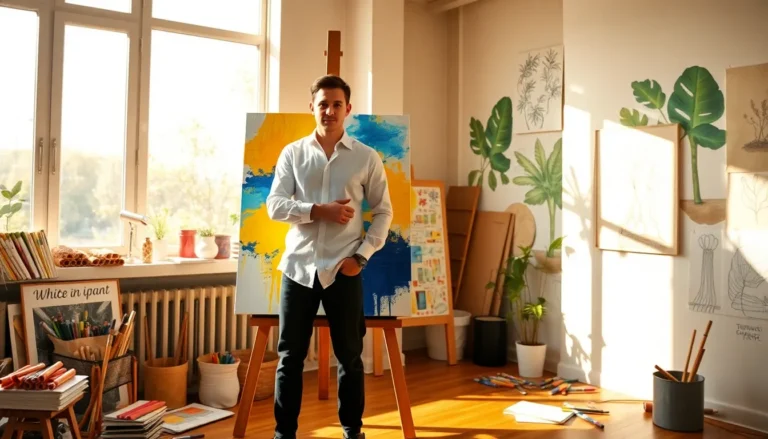Table of Contents
ToggleImagine sipping your morning coffee while basking in the sun, or hosting a barbecue that seamlessly transitions from your cozy living room to a vibrant patio. Indoor-outdoor living isn’t just a trend; it’s a lifestyle that brings the best of both worlds to your doorstep. It’s where comfort meets nature, and who wouldn’t want to live in a place that feels like a permanent vacation?
The Concept of Indoor-Outdoor Living
Indoor-outdoor living merges indoor comforts with outdoor beauty to create a harmonious lifestyle. This style emphasizes seamless transitions between spaces, allowing individuals to enjoy nature without sacrificing conveniences.
Benefits of Indoor-Outdoor Living
Enhanced well-being characterizes indoor-outdoor living, as natural light and fresh air improve mood and reduce stress. Increased social interaction occurs when spaces allow easy hosting of gatherings or family activities. Energy efficiency also benefits because access to natural ventilation reduces reliance on heating and cooling systems. Furthermore, unique designs promote a sense of tranquility by inviting nature indoors, creating a relaxing atmosphere. Home value sees potential increases, as buyers appreciate the appeal of versatile living arrangements.
Design Principles for Indoor-Outdoor Spaces
Creating fluid transitions defines effective design for indoor-outdoor spaces. Use large glass doors and windows to connect with outdoor areas while maximizing light. Selecting durable materials ensures longevity; choose weather-resistant furnishings and finishes. Incorporating greenery both inside and outside enhances the aesthetic and brings a refreshing touch. Each zone requires its identity, so integrate distinct elements to differentiate between indoor and outdoor settings. Finally, focus on comfort with ample seating and vibrant textiles to encourage relaxation in both environments.
Key Elements of Indoor-Outdoor Living

Indoor-outdoor living emphasizes connecting the comfort of indoor spaces with the beauty of the outdoors. This lifestyle focuses on elements that enhance the flow and ambiance of both environments.
Seamless Transitions
Seamless transitions serve as a foundation for indoor-outdoor living. Large glass doors allow for unobstructed views and easy movement between spaces. When owners utilize patios or decks, they expand living areas significantly. Integrated design features, such as flooring materials and cohesive color palettes, enhance continuity. Using retractable screens additionally provides flexibility for ventilation while keeping insects out. Structures like awnings and pergolas define outdoor spaces while protecting from sun exposure.
Natural Light and Ventilation
Natural light and ventilation play crucial roles in indoor-outdoor living. Skylights and expansive windows create bright interiors, minimizing the need for artificial lighting. Fresh air significantly improves indoor air quality, promoting overall well-being. Cross-ventilation strategies allow breezes to flow freely throughout spaces, reducing reliance on air conditioning. Integrating plants indoors and outdoors encourages a natural flow, enhancing aesthetics and comfort. With thoughtful placement of windows and doors, owners can enjoy a vibrant, inviting atmosphere year-round.
Popular Design Styles
Various design styles enhance indoor-outdoor living, creating unique atmospheres in homes. These styles cater to different tastes and preferences, offering diverse aesthetics and functionality.
Modern Indoor-Outdoor Living
Modern indoor-outdoor living emphasizes sleek lines and minimalistic design. Large glass walls allow natural light to flood interiors while providing unobstructed views of the outdoors. Open floor plans create a seamless flow between spaces, encouraging social interaction and relaxation. Using neutral color palettes and contemporary furniture enhances the airy feel. Incorporation of smart home technology supports energy efficiency and comfort, aligning with today’s eco-conscious lifestyle. This style appeals to those who value simplicity and sophistication in their living environment.
Rustic Indoor-Outdoor Aesthetics
Rustic indoor-outdoor aesthetics celebrate natural materials and textures. Warm woods, stone accents, and organic fabrics contribute to an inviting atmosphere. Spaces often feature cozy seating arrangements that encourage gatherings and connection with nature. Nature-inspired color schemes, from earthy greens to soft browns, enhance the overall warmth. Outdoor elements, like fire pits and wooden decks, extend living areas and promote outdoor activities. This style appeals to individuals who seek comfort and charm in their surroundings.
Creating Your Own Indoor-Outdoor Space
Creating an inviting indoor-outdoor space enhances lifestyle and well-being. Thoughtful planning ensures functionality and aesthetic appeal.
Planning and Layout
Start by considering the flow between indoor and outdoor areas. Define specific zones for dining, relaxing, and entertaining. Choose furniture arrangements that encourage social interaction. Establish pathways that connect spaces seamlessly. Mark the boundaries of each zone using different materials or elevation changes. This approach maintains clarity while promoting movement. Flexibility allows for adjustments as needs change. Incorporate shades, pergolas, or awnings for comfort on sunny days. When aligned correctly, spaces reflect a harmonious balance with nature.
Choosing Materials and Furnishings
Select weather-resistant materials for durability. Teak and eucalyptus are excellent choices for outdoor seating. Opt for vibrant textiles that withstand the elements. Cushions and throws add comfort, while resistant fabrics simplify cleaning. Consider cohesive color schemes that connect indoor and outdoor palettes. Natural stone, wood, or composite decking create a seamless look. Incorporate plants within spaces to enhance aesthetics and air quality. Use statement pieces like sculptural planters for visual interest. Prioritize comfort with ample seating, ensuring gatherings feel inviting. These elements contribute to the overall ambiance, reinforcing the indoor-outdoor lifestyle.
Embracing indoor-outdoor living transforms everyday experiences into moments of joy and connection. It fosters a lifestyle that prioritizes well-being and encourages interaction with nature. By thoughtfully designing spaces that flow seamlessly between indoors and outdoors, homeowners can create inviting environments that enhance both relaxation and social gatherings.
The right combination of design elements and materials can elevate any home, making it a sanctuary of comfort and beauty. This lifestyle not only enriches daily living but can also increase property value, making it a wise investment. Ultimately, indoor-outdoor living invites everyone to enjoy the best of both worlds, blending the comforts of home with the allure of the great outdoors.




